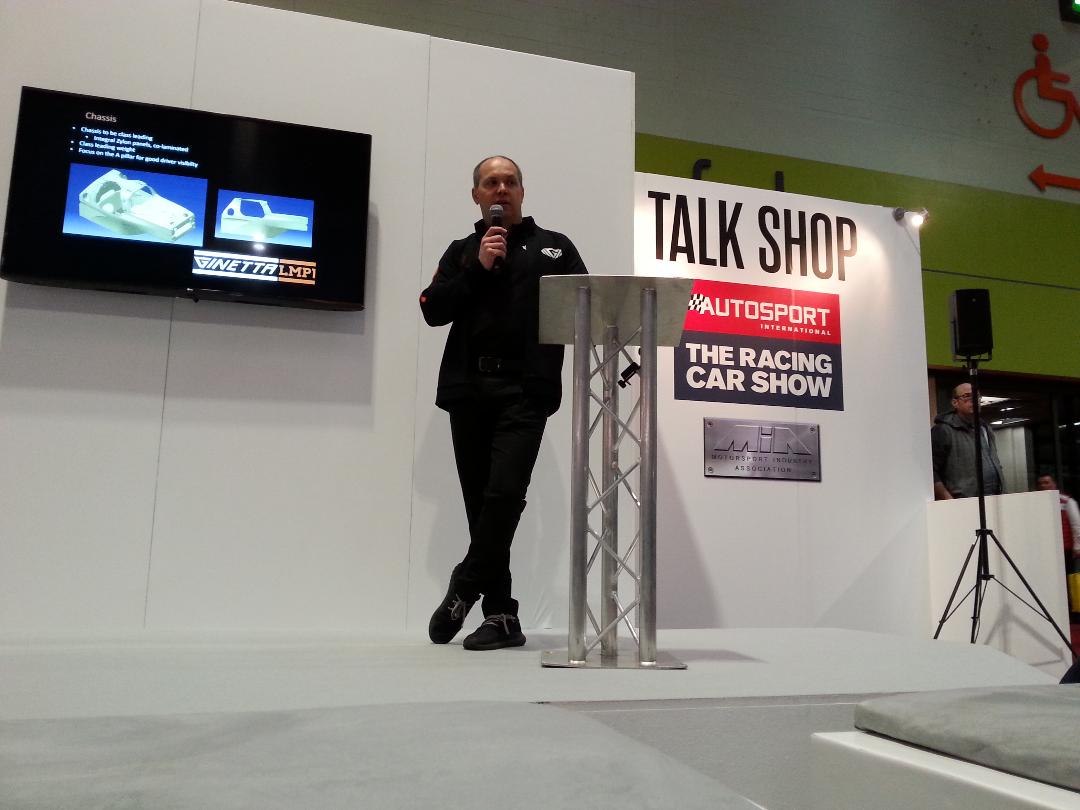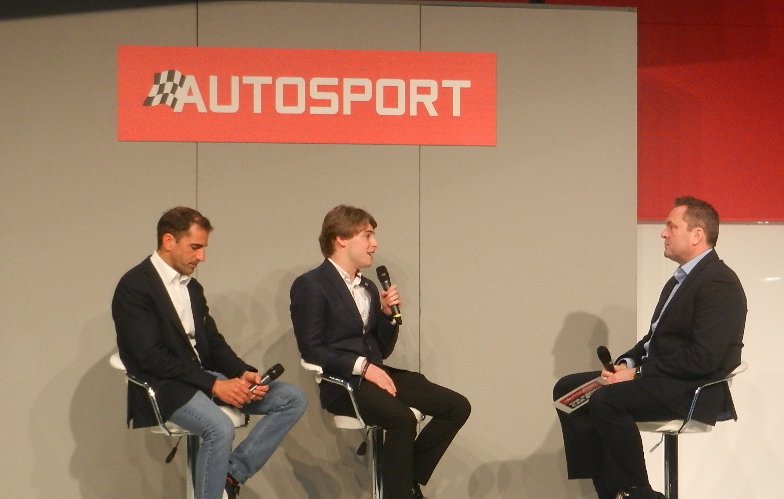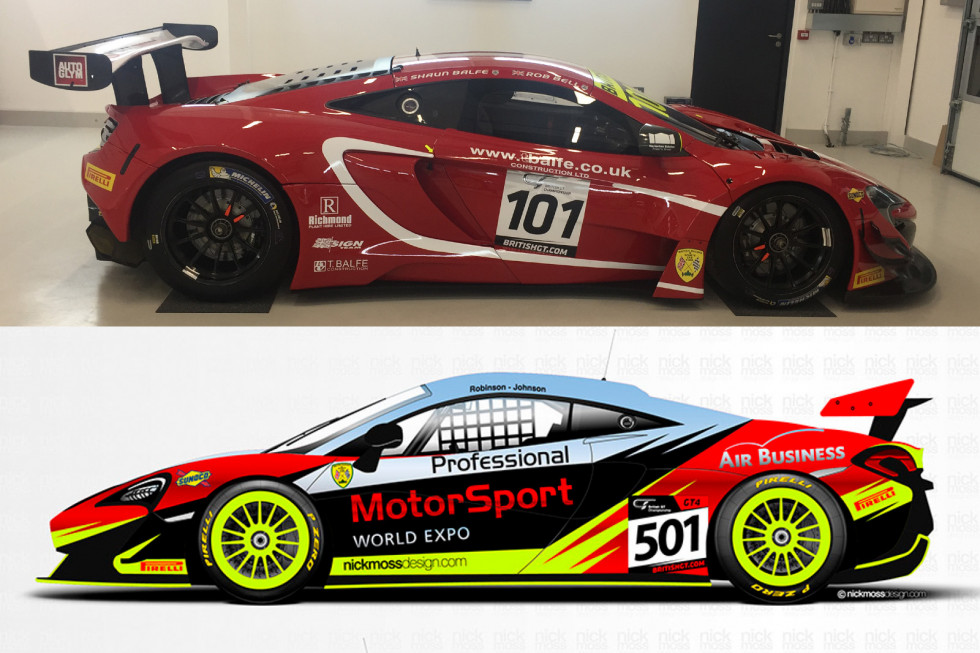
“We Believe That We’ve Created A Chassis That Is Class-Leading.” Ginetta’s Technical Director Ewan Baldry At Autosport 2018 (22.01.18)
January 22, 2018The highlight of the 2018 Autosport Racing Car Show for many endurance racing enthusiasts was the presentation and launch of the new Ginetta G60-LT-P1, the new-for 2018 LMP1 car of which TRS-Manor has already announced it will take delivery of two examples for entry into the 2018/19 FIA World Endurance Championship ‘Super Season’.
Ginetta Technical Director Ewan Baldry spoke additionally at the show to give some insight into the design and build of one the most exciting prototype projects for many years.
Below are some edited and summarised highlights from Ewan Baldry’s presentation.
Engine and Major Component Suppliers:
“Obviously we had designed an LMP2 car before, we had designed an LMP3 and the G58 and G57 cars which are prototype-based but to design a car like this and attempt to sell it for £1.3m, which is what the rolling chassis cost, without an engine, it’s quite a big ask and requires a good level of credibility. So it was logical for us to get on board with a good number of technical partners who could help with the credibility of that programme. The first on that list is Mecachrome. I was at the Cologne motorsport show last November and found their new GP2 engine on a turbo supplier’s stand. I got talking and went to visit them and found that they had assembled all the Renault Formula 1 engines since the year ‘dot’ right to now so they have a huge knowledge of wealth and experience and it’s been great to have them on board.”
“Xtrac is a no-brainer choice for a gearbox for this type of application.”
“The next one is ARS, a composites company. They’re Italian and they’ve had experience of manufacturing composites for programmes like this.”
“The next one is a special one for me. I started my motorsport career because when I was at university I came home after a night out and in those days Open University programmes used to be on the telly in the middle of the night. There was a programme about Reynard Racing Cars and at that point I decided that that’s what I wanted to do. Just a year ago I got introduced to Adrian Reynard who was my hero and we basically recruited their company to do our CFD services and I now count him as a friend which is great.”
“For the wind tunnel programme we chose Williams. I’m not sure you could choose anybody better. “
“And again, I think you would agree, some top-notch names; Öhlins for dampers, Bosch for the electronics, BBS for the wheels and AP for the braking equipment. “
Project Targets:
“Clearly the car has got to be reliable, it’s got to be serviceable and there are a lot of regulations around it as well. The real places where we could make a difference are aero-dynamically and the mass distribution of the car.”
“In terms of engine performance, again, it is relative given. The ACO have a fuel-flow method for controlling engine performance so they tend to cap engine performance by looking to cap the amount of fuel you’re allowed to use per hour so our real focus tended to start on the light weight of the vehicle and we were delighted the other day to put the car on the scales. You never really know until you’ve finished the car and put it on the scales how much it is going to weigh. The minimum weight limit when we line up on the grid at Le Mans this year is 833 kgs so that’s the minimum it’s got to be but your objective is always to make it as light as possible can so then you can apply ballast to the car which will give you performance in terms of the dynamic of the car. Also with a car like this, getting mass distribution forward is always a key requirement, a key focus and a key challenge too. The reason for that is obviously we need to work the front tyres in order to get the energy in them in order for them to heat up. It’s always a tricky thing to do so in order to do that you want to move weight, move ballast forward it gives the tyres more to do and obviously therefore enables them to warm and get into their key operating range.”
“So throughout the process I had to keep going to the CEO of the company to say can we spend a little bit more to take a little bit more weight out of the vehicle and the net result of that was we put the car on the scales the other day and it was 756 kgs. There was only a radio and a drinks system to go in there so we were miles under the 833 kgs target. The down side of that is that I then had to go to my boss and say you know I’ve been asking to spend a bit more money to make the car lighter. Well I now need to spend £25,000 on ballast to get the car up to the weight limit so it didn’t go down too well!”
Aero Package:
“What we’ve done is produced quite a high nose concept. If you look at the car and look down the gap between the side-pod and the front ‘elephant’s foot’ as we call it, you’ll see a void and the reason is to get the front end working first of all. Any aero designer will always start with the front splitter as they’re called, it’s more complex than a splitter, but they’ll start with that and the whole design feeds from that. They’ll focus on that bit first and that’s what we did. That said, we didn’t go quite as extreme as the Audi that never ran. They went really high nose for that but we needed to make sure we compromised slightly to ensure we had good driver comfort. We needed to make sure it was a bit more accessible so what we did was we built a wooden mock-up very early on that had a moveable foot-box and we got a range of drivers to sit in and arrived at what we thought was a good compromise and you will see the results over there. “
Aero Development:
“As I mentioned we used ARC in Indianapolis which is Adrian Reynard’s company and just to explain – they didn’t design anything for us – we design everything in-house at Ginetta. Our objective is always looking at the lift-drag ratio. That’s the result that we’re interested in – how much downforce we can generate for the amount of drag – there is a bit of a trade-off. So we did, I can’t totally remember, it must have been three or four hundred iterations of CFD throughout the programme of the car and it’s still on-going actually.”
“Once we’d arrived at what we thought was a good starting point for developing and testing further we then moved on to the wind tunnel programme.”
“A friend of mine who was an ex-F1 analyst travelled the world looking at various wind tunnel opportunities and decided to stay at home really and use Williams in the end and I’m really glad that we did. So we used Tunnel No1 at Williams which is where they won all the world championships. Tunnel 1 runs a 50% scale model. It has a moving table so it allows the car to yaw. So every time we did an iteration or a run of the car the model makers would make the changes to the car, they come out of the tunnel, the tunnel gets locked down, they press the button and start it and we record all the numbers. So at each iteration the car runs through a cycle – a complete range of pitch, a complete range of roll, a complete range of steer and also of yaw. So after every run we’d got a lift-over- drag number for each of those.”
“So the other key thing we did here – we took the decision to go with pneumatic tyres which again was an expensive decision to take but again with a car like this the flow of the car is so significant to the overall performance and the tyres affect that significantly. If you take a slightly cheaper route you take a solid carbon fibre wheel / tyre but it doesn’t deform in the way that a rubber one obviously does and when the car steers, pitches and rolls we want to try and get deformation so what happens is that the guys at Williams take the Michelin or the Dunlop tyre that we would use in real life and they perform a test where they load the tyre and look at the contact patch and change and then we use an Italian company to look at that and make us a model tyre – 50% tyre – from rubber and it get inflated and then they try to match that contact patch deformation that occurs so we get good representation of what is going on under the car.”
Engine:
“We also wanted to design it around a specific engine although other engines are available and the tub has been designed to accept other possible engine configurations as it’s a customer race car we’re selling. That said, we strongly would advise to go down the Mecachrome route – it’s been a fantastic process so far working with them and to that end as well as I’ll tell you about shortly, the gearbox has been designed to bolt straight to the engine so there’s no integral bell-housing which again gives us benefits in terms of structural stiffness, weight etc.”
“The base of the engine is the GP2 engine and the thing that appealed to us about it was that, first of all, it’s tiny but most of all I guess is that as part of the GP2 signing-off process they’ve had to do hours of durability testing as part of their contractual obligations for Formula 2. So all of the reciprocating components in the engine have gone through that durability programme. What we’ve done is turn the engine into GDI so it’s direct injection. The F2 engine isn’t. For Le Mans, to be competitive, you have to have good fuel efficiency so we had to switch to GDI which gives us 10% – 15% improvement in efficiency. But it is not the work of a moment and Mecachrome have spent all of the nine months that we’ve been developing the new car, developing g the new casting and the new cylinder heads for GDI. We fired up the engine for the first time last Tuesday before we brought the car here and I’m pleased to say it doesn’t sound anything like a Formula 1 engine. It sounds fantastic – it really screams.”
“It’s a ‘Hot V’ so the turbo sits in the V rather than on the flanks of the engine which has been really good for the cooling package and packaging in general.”
Gearbox:
“In terms of the gearbox we did look around but we decided to go with Xtrac for fairly obvious reasons as they’ve got an incredible pedigree at Le Mans and the 24 Hours. I don’t know what the numbers are but I guess that last year they must have had 75% of the cars on the grid. We’ve taken a gear cluster that has won Le Mans many times so we didn’t want to reinvent the wheel. What we have done is twisted the cluster slightly to make it go further forwards and lower in the interest of the C of G. The other interesting thing is that, with Xtrac, we have designed our own casing so whereas other cars who use an off-the-shelf gearbox use an adaptor, our case is custom so it bolts straight to the back of the Mecachrome engine. “
Chassis:
“On to the chassis. To our knowledge, we’re not totally sure, but to our knowledge this is the first car to have Zylon panels integrated into it . Zylon panels are effectively mandated by the regulations – they’re effectively an impact resistant structure. And normally they get laminated and cured separately onto the chassis and the bonded on which means that you don’t really get much performance from them other than when the impact happens – if it happens. However the reason it’s done that way is that they generally don’t bond very well in testing of the systems that have been used previously. ARS, the company that we use, and the materials supplier have come up with a new resin system that has enabled them to co-laminate the Zylon into there. So we believe that we’ve created a chassis that is class leading. It weighs just under 60 kgs and our knowledge in terms of everything in LMP2 is that they’re around 75kgs’ I’m not sure what an Audi or a Toyota would be . I’m sure we’re knocking on the door of what they’ve achieved so we’re delighted with that. “


